(MENAFN- Kashmir Observer) Development of the concept
ADVERTISEMENT
The concept of bilingual education gained more formal attention in the 20th century as migration, globalization, and international relations increased. People from different language backgrounds began to interact and live together in various countries, creating a demand for educational approaches that could address the linguistic needs of diverse communities. The early initiatives of bilingual education aimed to assimilate immigrant populations into the dominant language and culture of their new countries. However, as educators and researchers delved into language acquisition and cognitive development, they recognized the cognitive advantages of being bilingual and the importance of preserving one's cultural identity and native language. In the mid-20th century, various bilingual education models emerged, and educators started advocating for bilingual programs that would foster proficiency in both the students' native language and the dominant language of the society. The idea was that bilingual individuals could be better equipped to participate in a globalized world, both culturally and economically. Over time, the concept of bilingual education has evolved, with a greater focus on promoting cultural diversity and providing students with the tools to become effective communicators in multiple languages. Bilingual schools have become centers of excellence in language learning, cultural exchange, and international understanding. As we move further into the 21st century, the concept of bilingual education remains relevant and vital in an increasingly interconnected and diverse world.
Benefits of the system
Real Also sehat: government's health schemes is a ray of hope for poor 4 years of development: important stimulus to aspirational society The concept of bilingual education and bilingual schools offers a wide range of benefits, not only for individual students but also for society as a whole.
The most obvious advantage is that students in bilingual schools develop fluency in two languages. This ability to communicate effectively in multiple languages opens up a world of opportunities for personal, academic, and professional growth.
Bilingual education has been linked to cognitive advantages, including improved executive functions, such as problem-solving, multitasking, and decision-making. Bilingual individuals often exhibit better metalinguistic awareness, which means they can analyze and understand language structures more effectively.
It fosters cross-cultural understanding and appreciation. Students in bilingual schools are exposed to different cultures, traditions, and perspectives, promoting empathy and global citizenship.
Research suggests that bilingual students may perform better academically in certain subjects, such as math and reading, due to the cognitive benefits and increased mental flexibility associated with bilingualism.
Bilingual individuals tend to be more adaptable and open-minded, as they are accustomed to navigating different linguistic and cultural environments. This adaptability can be a valuable asset in a rapidly changing world.
In many job markets, bilingualism is highly valued and sought after. Being fluent in multiple languages can lead to more employment opportunities and career advancement, especially in international business, diplomacy, and other global professions.
They often have a deeper understanding of language structures and nuances, making them effective communicators in both their languages. This skill can lead to better interpersonal relationships and effective communication in professional settings.
An education which is bilingual contributes to building a more inclusive and diverse society. It breaks down language barriers and encourages mutual understanding, tolerance, and respect among different communities.
Prospects of bilanguage system
Some of the key challenges of the bilingual concept include:
a. Limited Resources: Implementing a bilingual education program requires substantial resources, including qualified bilingual teachers, instructional materials in multiple languages, and adequate language learning facilities. Not all schools or educational systems may have the necessary resources to support bilingual education fully.
b. Teacher Shortages: Finding and retaining qualified bilingual teachers can be challenging. Bilingual educators need to be proficient in both languages of instruction and possess effective teaching skills in both languages. A shortage of such teachers can hinder the expansion of bilingual programs.
c. Balancing Languages: Ensuring a balanced level of proficiency in both languages can be difficult. In some cases, one language may dominate over the other, leading to imbalances in students' language skills.
d. Language Attitudes and Perception: Societal attitudes towards bilingualism can vary. Some people may view bilingual education as unnecessary or less valuable than monolingual education, leading to misconceptions and resistance to bilingual programs.
e. Time Constraints: Incorporating two languages into the curriculum can lead to time constraints, potentially affecting the depth of instruction in other subjects. Schools must strike a balance between language learning and other essential academic areas. f. Social Stigma: In some cases, bilingual students may face social stigma or discrimination due to their language background. This can impact their self-esteem and hinder their willingness to participate actively in bilingual programs. Addressing these challenges requires careful planning, collaboration among stakeholders, ongoing research, and a commitment to promoting bilingual education as a valuable and effective approach to learning.
Dr. Rajkumar Singh is a Youth Motivator, presently Professor of Political Science and Dean of Social Sciences along with Dean, Student's Welfare (DSW), at B.N. Mandal University, Madhepura (Bihar), India. His 25 books published in addition to about 1000 articles in national and international journals and daily newspapers from 25 foreign countries
follow this link to join our whatsapp group : join now




















Comments
No comment